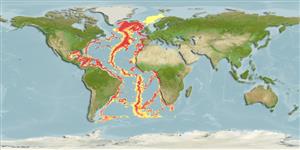Classificatie / Names
Lokale namen | Synoniemen | Catalog of Fishes(Genus, Soort(en)) | ITIS | CoL | WoRMS | Cloffa
>
Ophidiiformes (Cusk eels) >
Ophidiidae (Cusk-eels) > Neobythitinae
Etymology: Penopus: Greek, penia, -as, penomai = poverty + Greek, pous = feet.
More on author: Vaillant.
Environment: milieu / climate zone / depth range / distribution range
Ecologie
marien bathydemersaal; diepte 960 - 3535 m (Ref. 34024). Deep-water
Western Atlantic: from 38°29'030''N, 70°57'W (holotype of P. macdonaldi) southwards through the Gulf of Mexico to 22°45.7'S, 40°19.6'W. East Atlantic: from 34°28'N, 7°43'W southwards through the Gulf of Guinea to 36°06'S, 19°33'E.
Grootte / Gewicht / Leeftijd
Maturity: Lm ? range ? - ? cm
Max length : 35.0 cm TL mannelijk / geslacht onbekend; (Ref. 4103)
Dorsale stekels (totaal): 0; Dorsale zachte stralen (totaal): 135-158; Anale stekels 0; Anale zachte stralen: 106 - 122; Wervels: 77 - 83. Penopus microphthalmus differs from P. japonicus by the following characters: has a higher number of dorsal, 135-158 (vs. 117) and anal, 106-122 (vs. 89) fin rays; lower number of preopercular spines, 4-7 (vs. 9); indistinct spine behind the posterior nostril (vs. distinct, 1% SL); by the bigger horizontal diameter of the eye 1.1-1.6% SL (vs. 0.8); and in having an almost fully scaled head (vs. squamation of the head restricted to the middle part of the preopercle) (Ref. 87601).
Rare species (Ref. 34024). Oviparous, with oval pelagic eggs floating in a gelatinous mass (Ref. 205).
Levenscyclus en paargedrag
Maturiteit | Voortplanting | Paaien | Eieren | Fecunditeit | Larven
Nielsen, J.G. and S. Ohashi, 2011. A new species of Penopus (Teleostei: Ophidiidae) from the Ryukyu Trench, the West Pacific, with remarks on Penopus microphthalmus. Ichthyol. Res. 58(3):232-237. (Ref. 87601)
Status op de Rode Lijst van het IUCN (Ref. 130435)
Gevaar voor de mens
Harmless
Gebruik door de mens
Visserij: van geen belang
Meer informatie
Lokale namenSynoniemenMetabolismePredatorenEcotoxicologieVoortplantingMaturiteitPaaienPaaiaggregatiesFecunditeitEierenOntwikkeling van de eieren
Leeftijd/GrootteGroeiLengte-gewichtLengte-lengteLengtefrequentiesMorfometrieMorfologieLarvenLarvale populatiedynamiekRekruteringAbundantieBRUVS
ReferentiesAquacultuurAquacultuurprofielKweeklijnenGeneticaElectrophoresesErfelijkheidZiektesVerwerkingNutrientsMassaconversie
Tools
Speciale rapporten
Download XML
Internetbronnen
Estimates based on models
Preferred temperature (Ref.
123201): 2.2 - 5.1, mean 3.9 °C (based on 844 cells).
Fylogenetische diversiteitsindex (Ref.
82804): PD
50 = 0.7500 [Uniqueness, from 0.5 = low to 2.0 = high].
Bayesian length-weight: a=0.00110 (0.00041 - 0.00296), b=3.08 (2.85 - 3.31), in cm total length, based on LWR estimates for this (Sub)family-body shape (Ref.
93245).
Trofisch niveau (Ref.
69278): 3.6 ±0.6 se; based on size and trophs of closest relatives
Weerstandsvermogen (Ref.
120179): Gemiddeld, minimale populatieverdubbelingstijd 1,4-4,4 jaar (Preliminary K or Fecundity.).
Fishing Vulnerability (Ref.
59153): Low vulnerability (25 of 100).
